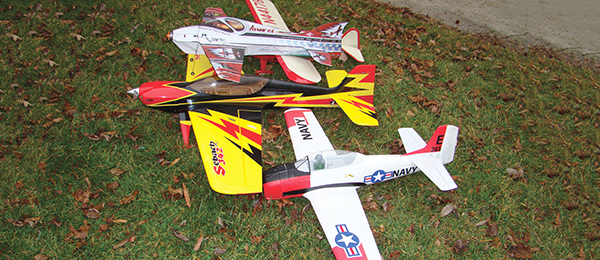
Article and photos by the author. Featured in the Spring 2013 issue of Park Pilot.
Pictured above is a variety of my favorite park flyers: the DonatasDesign Arrow V6, ParkZone T-28 Trojan, E-flite Taylorcraft 450 and the SebArt SBach 342. All of these airplanes are fun to fly, although their aerobatic capacities vary widely. A lot of hangar talk takes place about what kind of aerobatics can be completed with a given airplane or pilot, and how best to fly given aerobatic maneuvers. Although it is possible to hover and torque roll certain primary flight trainers, learning to hover will be much easier with a proper, aerobatic airframe. This leads to my topic: aerobatics cross-training. What is aerobatics cross-training, and when is it needed and most beneficial? The basic idea is to incorporate methods and elements into a training regimen that is not specific to, but is in some way related to, the primary goal. Batting practice might initially be the best way to improve one’s ability to hit a baseball, but at some point, it can be beneficial to split batting practice with strength training, calisthenics or exercises to improve hand-eye coordination. Aerobatics cross-training is beneficial whenever a maneuver is too difficult to accomplish in a single step, or when learning a maneuver can be accomplished in a shorter time period by incorporating cross-training techniques. One clear example is rapid, consecutive horizontal rolls on the deck. Although it’s possible to learn this maneuver by repeatedly attempting it at sufficient altitude to allow bailouts, using cross-training techniques can often get you to the desired goal faster.

The light wing loading of the E-flite Taylorcraft 450 can deliver substantial aerobatic capacity in the hands of an advanced pilot. This model excels at high-angle slips and one-wheel touch-and-goes.

Slightly larger than the typical park flyer, the SebArt SBach 343 can deliver a wide mix of 3D and precision aerobatics.
For many pilots who are not yet capable of completing rapid consecutive rolls, the maneuver often happens too fast to see what, when and how long each control input is being used. Short segments of straight, inverted flight on the surface would seem to have little to do with rapid consecutive rolls, however, flying straight, inverted segments can “train” the pilot to know how much down-elevator is needed during the inverted portion, and ultimately make it easier to fly consecutive rolls. The next step could be short segments of knife-edge flight to learn how much rudder input is needed during the knife-edge portion of the rolls. Follow with multiple slow rolls, in which the timing for each input is easier to see, and the blending of inputs can be adjusted to provide smooth transitions between them. This example of cross-training with flight techniques is only a part of what I consider to be aerobatic cross-training. Aerobatic cross-training also includes learning and performing maneuvers with different aircraft. For the advanced aerobatic pilot, hovering and torque rolling a high-quality 3D aircraft like the SBach or Arrow is not challenging. However, hovering a high-wing, sport model like the Taylorcraft can be challenging, yet ultimately beneficial. Because the Taylorcraft is much less stable in a hover, it requires far more control inputs of greater variability, and ultimately, a much higher pilot workload. When a pilot is able to hover the Taylorcraft, hovering the SBach or Arrow is easy. The degree of how much cross-training is beneficial will depend on the pilot’s skill level and goals. For relatively novice pilots, the goal is generally learning basic aerobatics; fine points and advanced maneuvers are not the focus. It is more important for the pilot to be comfortable with the airplane, so that the workload to fly it is not too high, and mental resources are available for learning the basic aerobatics.

With its primary mission of indoor flying, the DonatasDesign Arrow V6 is a highly refined aerobatic machine, capable of extreme 3D flight. This extraordinary model can maneuver in the tightest spaces.

The ParkZone T-28 Trojan is a very versatile airframe. Low weight, ample dihedral and a semisymmetrical airfoil make it a good post-trainer candidate for basic aerobatics.
The ParkZone T-28 and E-flite Taylorcraft are great examples of airplanes that can be handled easily by novice pilots, but still have the capacity to deliver substantial aerobatics. Loops, stall turns, spins and inverted flight are well within the range of these airplanes. With a more rearward CG and increased control throws, snap rolls, flat spins and rolling loops become possible. Another staple maneuver of advanced pilots is the broad variety of rolling loops. Although rolling loops are possible with the Taylorcraft, the Arrow or SBach will complete this type of maneuver with less workload on the pilot. The Taylorcraft excels at high-angle slips — impressive when done with precision — although more difficult to accomplish with the Arrow or SBach. With its primary mission of flying indoors, the 5.5-ounce Arrow is capable of extremely rapid changes in direction, but with very low inertia, it will not complete tumbling maneuvers that are possible with the SBach and Taylorcraft. Simply stated, not all maneuvers are possible with all aircraft.
Article:





